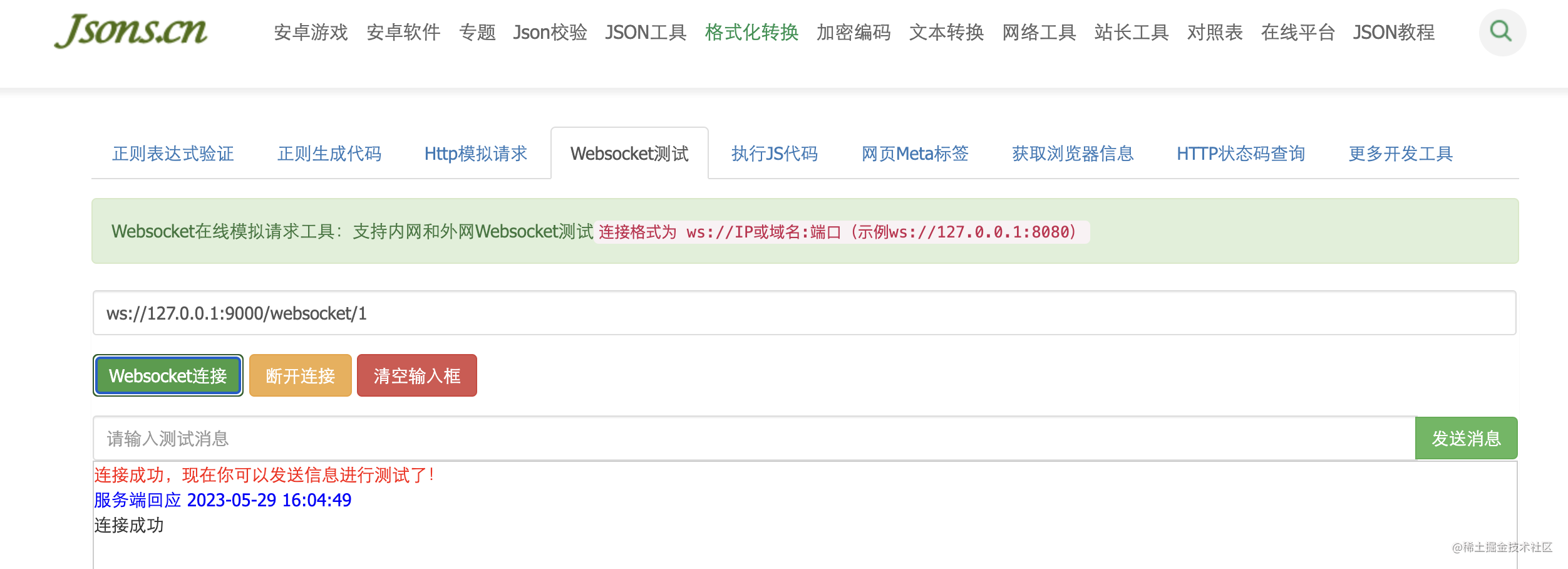日常工作中,我们都是使用http请求,来进行前后交互,那么我们也会有使用websocket来进行前后交互的时候,那么它俩有什么区别呢?
http和websocket区别
- WebSocket是双向通信协议,模拟Socket协议,可以双向发送或接受信息
- HTTP是单向的
- WebSocket是需要浏览器和服务器握手进行建立连接的
- 而http是浏览器发起向服务器的连接,服务器预先并不知道这个连接
根据它的特点就可以知道,如果场景中需要服务端向客户端推送消息,那么使用http就是不行的。所以今天就用spring boot 来接入 WebSocket。
代码实现
1、首先,我们需要在pom文件内引入它的jar包依赖,如下:
<!--websocket作为服务端-->
<dependency>
<groupId>org.springframework.boot</groupId>
<artifactId>spring-boot-starter-websocket</artifactId>
</dependency>
这个时候我们就可以直接利用该第三方的API直接代码实现了。
新增websocket配置类
因为项目中有http请求,也有websocket请求,那么该怎么去区分请求连接的类型呢?这个时候我们需要增加一个websocket的配置类,来进行拦截websocket的请求。
@Configuration
public class WebSocketConfig {
/**
* 注入ServerEndpointExporter,
* 这个bean会自动注册使用了@ServerEndpoint注解声明的Websocket endpoint
*/
@Bean
public ServerEndpointExporter serverEndpointExporter() {
return new ServerEndpointExporter();
}
}
注意:不要忘记添加 @Configuration 注解,这个类,会自动拦截websocket请求。
完整代码
@Component
@Slf4j
@ServerEndpoint("/websocket/{userId}")
public class WebSocketHandler {
// 接口路径 ws://127.0.0.1:9000/websocket/userId;
private Session session;
//concurrent包的线程安全Set,用来存放每个客户端对应的WebSocket对象。
private static CopyOnWriteArraySet<WebSocketHandler> webSocketUtils = new CopyOnWriteArraySet<>();
// 用来存在线连接数
private static Map<String, Session> sessionPool = new HashMap<>();
/**
* 链接成功调用的方法
*/
@OnOpen
public void onOpen(Session session, @PathParam(value = "userId") String userId) {
try {
this.session = session;
webSocketUtils.add(this);
sessionPool.put(userId, session);
sendOneMessage(userId, "连接成功");
//加入队列
QueueUtils.addMap(userId);
log.info("【websocket消息】有新的连接,总数为:" + webSocketUtils.size());
} catch (Exception e) {
e.printStackTrace();
}
}
/**
* 链接关闭调用的方法
*/
@OnClose
public void onClose() {
try {
webSocketUtils.remove(this);
log.info("【websocket消息】连接断开,总数为:" + webSocketUtils.size());
} catch (Exception e) {
e.printStackTrace();
}
}
/**
* 收到客户端消息后调用的方法
*
* @param message
* @param
*/
@OnMessage
public void onMessage(@PathParam(value = "userId") String userId, String message) {
log.info("【websocket消息】收到客户端消息:" + message);
if (!StringUtils.isEmpty(userId) && !StringUtils.isEmpty(message) && message.equals("ping")) {
sendOneMessage(userId, "pong");
} else {
//1、轮询用户数最少的服务器IP
String serverIP = QueueUtils.getServer();
log.info("serverIP为:" + serverIP);
//2、调用大模型
WebSocketClient client = JavaClient.getClient(userId, serverIP);
if (client != null) {
JSONObject object = new JSONObject();
object.put("", message);
String[][] strings = {
{"aaa"}};
object.put("history", strings);
object.put("knowledge_base_id", "/home/nemo/aigc/langchain-ChatGLM/vector_store/knowledge_FAISS_20230516_133609");
//3、发送问题
client.send(object.toString());
}
}
}
/**
* 发送错误时的处理
*
* @param session
* @param error
*/
@OnError
public void onError(Session session, Throwable error) {
log.error("用户错误,原因:" + error.getMessage());
error.printStackTrace();
}
/**
* 推消息给前端
*
* @param userId
* @param message
* @return
*/
public static Runnable sendOneMessage(String userId, String message) {
Session session = sessionPool.get(userId);
if (session != null && session.isOpen()) {
try {
log.info("【推给前端消息】 :" + message);
//高并发下,防止session占用期间,被其他线程调用
synchronized (session) {
session.getBasicRemote().sendText(message);
}
} catch (Exception e) {
e.printStackTrace();
}
}
return null;
}
}
测试
我们可以使用第三方websocket在线测试工具,http://www.jsons.cn/websocket/,连进行测试。
我们可以发送请求连接为:ws://127.0.0.1:9000/websocket/1
然后点击Websocket连接,即客户端可以收到服务端的回应:连接成功。
